Flying a few miles off the Mayo coast
recently I was struck by how big and empty the sky was to the west.
Nothing but roiling sea stretched to the horizon, surmounted by
tumbling, menacing grey clouds. This part of the country is where
Alcock & Brown landed after their epic transatlantic transit in
1919. As I gazed down at Clifden, I boggled at why any pilot would
choose to land there – it’s wind-blasted, barren and boggy in equal
measure. Scarcely ideal landing grounds but paradise compared to the
surroundings at sea.
Further to the south but equally exposed to
the tumultuous Atlantic weather, Shannon Airport offers a similar
respite from elemental forces for transatlantic passengers to the
present day.
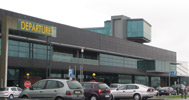
Shannon Airport was set up in the immediate
aftermath of the Second World War, when it became apparent that
flying boats were an evolutionary cul-de-sac. While great for
transatlantic flights they had limited options available to them in
the event of an emergency over dry land necessitating a quick
landing. Let’s not forget engines stopped a lot more frequently then
than they do now (the Lockheed Constellation was known for a time as
‘the best three-engined plane in the world’). Anyways the massive research
& development effort undertaken during the war saw the emergence
of civil airliners/military transports which could hop across the
Atlantic with a couple of strategically chosen fuel stops.
Shannon was one of those stops. In those days it was known
locally as Rinnena and was a flat piece of ground with not too many
inconvenient tenants other than the occasional seagull sitting out a
patch of bad weather.
It sits mere yards from the mouth of the Shannon, where
Ireland’s longest river flowed majestically along a widening estuary
into the Atlantic Ocean.
This meant there was no need for sewage treatment – the
airport’s waste could be pumped directly into the sea, cutting down
on infrastructure cost. This sort of carry-on is really an important
consideration for Irish planners – and you wondered why we were
renowned for our abilities to dig holes rather than for the glory of
our architecture.
Thus
established with hard runways in the triangular fashion of the time,
Shannon made its mark in the annals of aviation history long before
flying became a form of aerial cattle-trucking: Le Bourget – Shannon
– Gander – Idlewild. Ahh, the
glamour!
Always having an eye to the main chance, the
denizens of Shannon saw a chance to relieve rich transiting
Americans of some of their dollars. Thus was the traditional drink
of Irish Coffee invented (really!). Thus was the Airport Duty Free
Store invented (again, no
kidding!).
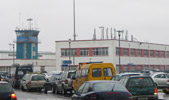
In
time, technology showed itself to be Shannon’s enemy however.
Increasingly, aircraft could make the journey across the Atlantic
without intermediate fuel stops and Shannon’s traffic waned.
Increasingly, its isolated position on an occidental finger worked
against it.
Reluctant to see a source of precious
regional jobs (and their attendant votes) dissipate, the Irish
Government legislated against technology – an act akin to King
Canute ordering the tide about, albeit one more popular with voters
in County Clare. It became mandatory for all transatlantic flights
to stop in Shannon Airport as the designated Irish trans-Atlantic
gateway. This piece of idiocy remains in place to this day in
slightly modified form.
If you live in Dublin, as so many of we Irish do, it is
similar to interrupting a long distance car journey at the bottom of
your own driveway for a comfort break.
It
applies on inbound flights also. Imagine the experience of
the first time American visitor who finds their overnight journey
prematurely interrupted. At five in the morning local time, their
body clocks already beginning to protest at the disjoint, the weary
traveller finds themselves forcibly deplaned for a ninety minute
layover in order that they may be tempted to spend dollars in a duty
free shop they never wanted to visit. Ironically, despite their
forcible attendance, they aren’t allowed to make any purchases in
said emporium even if they should so decide, as the next leg of
their flight is domestic and hence not eligible for duty-free
status! If you think this makes the foreign visitor irate, imagine
how we Dubliners feel.
We have our own cosy welcoming beds awaiting us not two
hundred kilometres away, having come a distance of several thousand
and we are forced to sit in this half-closed airport for ninety
minutes despite having spent our conscious lives up to that point
avoiding the Limerick area for reasons of personal
safety.
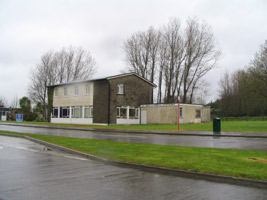
Having failed in their game attempt to
persuade foreign airlines to retain the DC-4 as their prime long
haul aircraft type and thus guarantee the future prosperity of the
Shannon basin region, the Irish Government came up with the idea of
the Shannon Free Zone, a novel tax wheeze of the sort the European
Commission was created to stamp out. The idea was rich foreign
corporations could establish factories in an industrial cluster
around the airport, importing raw materials and exporting finished
goods without payment of Irish tax. Except for Income Tax and
PRSI deducted from all those lovely voters they would be
employing.
Needless to say, it didn’t quite work out
like that. Sean Lemass’ dream of an industrialised Shannon and three
safe Clare seats next time out hasn’t quite worked out as
intended. Shannon Free
Zone is a sad reminder of how we saw the future in the 1960s. All
Northlight roofs and pebble-dash exteriors, like a countryside
bungalow on steroids.
There are no steel mills or shipyards (not that you’ll find
too many examples of either anywhere in Europe these days). Ireland skipped an
evolutionary step and went straight to software development and
financial services to power the Celtic Tiger. Shannon Free Zone remains as
a sad and slightly embarrassing reminder of the original plan A.
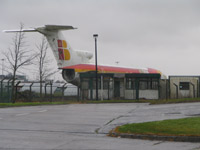
Still
it has some successes. Two of the world’s largest aircraft lessors
have bases there – AerFi and GE Capital. They operate from small neat
offices, with small neat professional staff and could relocate
anywhere else in the world the moment that the tax regime or the
Irish Aviation Authority turned against them. Aircraft maintenance
has also been a success with Lufthansa Technik having purpose-built
facilities dwarfing the old Shannon Repair Services hangar. Even local airtaxi outfit
Westair has a shining new hangar which makes their previous quarters
look like an outdoor privy.
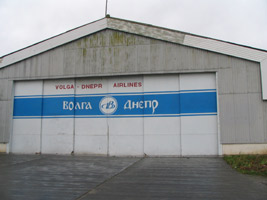
But
these are Darwinistic creatures, adapting to their environment to
survive. In reality,
Shannon Airport is a dismal place, located on the very edge of the
European disc. Paradoxically, that is why it has always held a
certain magic for me.
Despite being in the wilds of Ireland, it’s very American in
its nature, perhaps because so many of those that walk its halls
were in Newark a few short hours ago and haven’t yet adapted to the
fact that they’re literally not in Kansas anymore.
Stuffed on a back shelf beside an open window
in the catering area, you’ll find fresh unopened boxes of
Continental Airlines plastic courtesy goblets (three words that
really don’t belong in close proximity to each other). You’ll find
the occasional immersion-suited ferry pilot stepping out of a minute
Cessna, delirious from lack of sleep and overdosed on caffeine in
order to get their tiny charge across the pond and spare it the
rigours of shipping by container. You’ll find passing military
transport pilots from foreign lands strutting their stuff in the
halls – looking exotic and hard as nails. You’ll find corporate titans
beached for a fuel stop peeking nervously out the door of their
Gulfstream like small
children.
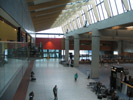
All
human life is there.
And yet, the locals have started to reclaim Shannon as their
own. Shannon is going
from low rent to low fares.
Ryanair offer flights from Shannon to twenty-five
destinations – the majority are its hubs in the UK but there are
three in each of France, Italy and Spain as well as two in
Poland. Truly Ryanair
has become our national flag-carrier, usurping Aer Lingus’
birthright. Like Shannon itself, it takes a very different form from
that originally envisaged but if it
works…

